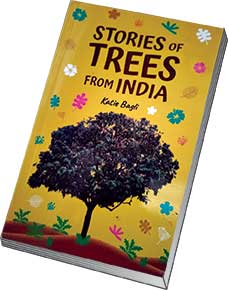Geetha Iyer
Stories of Trees from India, as the name suggests, is a book that has some delightful stories about trees along with some brief information about them. Some of the stories are those of the author’s imagination and some she has created based on historic events.
There are 23 stories introducing 23 commonly seen trees from the neighbourhood. Some of the trees, such as the coconut or jackfruit are seen easily in the southern part of India and uncommon in many parts of northern India. The language used by the author is simple and easy to read. The book is suitable for children of ages 10 to 12. It is also a book that can be used to initiate children into the habit of reading. Each story is only four to five pages long, followed by a page and a half about the tree. Hence it is ideal for beginners. The format used, stories plus facts, will interest adults too. Nuggets of information about the animals that depend on the tree, live or feed on its parts, serve to introduce kids to how a tree is more than an assemblage of roots, stem, leaves, flowers, and fruits. It makes clear that a tree is a kind of ecosystem of its own; a sanctuary for many creatures, weaving a web of life that sustains the lives of a variety of animals and plants as also humans.

Author: Katie Bagli
Publisher: Shree Book Centre
Number of pages: 200
Price: Rs 399
Available: www.shreebookcentre.com, Amazon
Information such as the trees which are food plants of caterpillars or butterflies is sure to be of help to teachers who are on the lookout for projects. Since teachers are likely to refer to this book for information, it is necessary that accuracy is not lost in trying to keep the language simple to understand. The way trees shed leaves varies from one geographical region to another. The term deciduous has been very loosely used by the author. Deciduous condition is not just about shedding of leaves by a tree but also about the need to do so, and the timing. In temperate regions deciduous trees shed leaves during cold months, whereas tropical trees shed their leaves during warmer times – spring to summer. So, trees such as Peepal, Neem, Pongamia, etc., are not deciduous. One doesn’t see them standing leafless as would be the case for a deciduous tree. These trees start shedding their leaves around February/March onwards; despite the shedding, one does not see them standing leafless. They are only briefly deciduous. The tree that stands leafless during the approach of warmer months is the silk-cotton tree. I quite liked the description by the author about this tree. I am sure kids will enjoy watching the butcher bird (long-tailed shrike) go about embalming the insects on the thorns. Macabre? May be, but a reminder to children that life is never easy for any creature. The story on the tamarind tree was also a delight to read.
I wondered why the author has restricted herself in giving names in Indian languages to just Hindi, Marathi, Gujarati, or occasionally Sanskrit. Is this book aimed at children who live in Maharashtra and beyond in Central and North India? There is a heavy tilt towards Maharashtra and Marathi names abound; the only state tree mentioned is that of Maharashtra. The author mentions that the Jackfruit is the state fruit of Kerala, yet the common Malayalam name for this tree is missing in the name list. Ditto for the coconut tree which incidentally is the state tree of Kerala – a fact that could have been included. Konnapoo is the local name for Indian Laburnum flowers and not the name of the chutney made from the flowers. Kadamb is an evergreen tree. Tree snippets about deodar – the Himalayan cedar could have been given in the same format as given for all other trees. I was a bit sad to see that only the cedar tree from the Himalayan regions was included. There are some very interesting trees with a lot of natural history to be found in this part. Disappointed to note that they could not be included.
Writing about any aspect of natural history requires long periods of observation along with substantial research. The love the author has for fauna and flora comes through very well in this book. A little more of research would have added a lot more value to this nice book and reduced the errors. Nevertheless, I am sure children will enjoy reading them as much as I did. The Hornbill chicks’ jetpoops would surely bring forth mirth and laughter. Mistaking the animals that visit the trees for ghosts would be a theme that kids will take to. I also hope teachers in schools can read out some of these stories in their class and use the information given to start a tree watch activity.
The author is a consultant for science and environment education. She can be reached at scopsowl@gmail.com.
